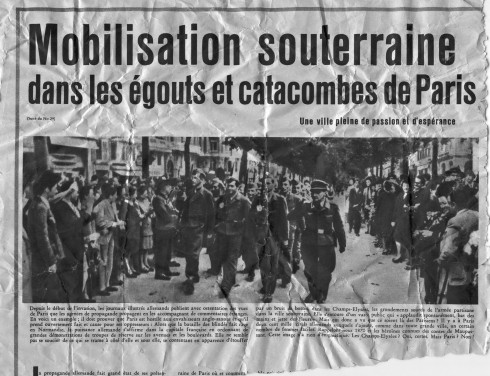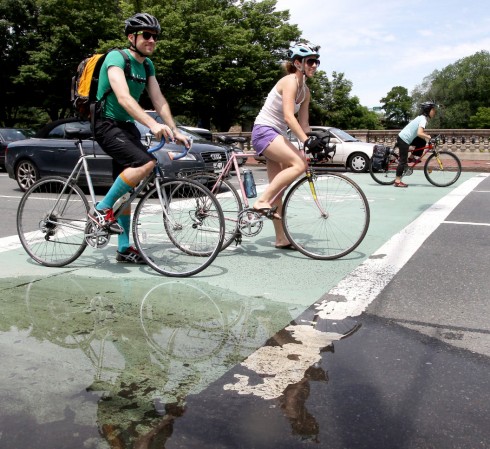I have my antennas tuned to the signals coming from the paint and path, anti-car, transportation reform segment of bicycling advocacy. I have no access to the messages which advocates of this stripe send to one another. But when I hear the same suggestions coming from multiple sources, I must conclude that there is communication among them.
Here’s the latest party line: bicycling will be better for us when we all ride very slowly. And we should not bother with helmets, because bicycling will become safer if we don’t.
I read it yesterday on an urban planning e-mail list in the following words: “The question … is one of helmets for all versus just riding a bicycle safely…I prefer seeing women, men and kids riding in safe environments en-mass [sic] which will then slow speeds and make bicycling in the city what we see in Amsterdam and Copenhagen and what we still see in China in many locations.”
I heard it again today on Robin Young’s Here and Now radio show on NPR. At the beginning of the show, host Young announced that a topic would be “is it possible that not wearing helmets makes bicycling safer?” The helmet segment consisted entirely of an interview with a guest Elizabeth Rosenthal, a public-health advocate. Here’s a link to the show segment: http://hereandnow.wbur.org/2012/10/02/lose-bike-helmets
The claim which underlies the party-line argument against helmet use is that if people don’t have to wear a helmet, then more people will ride bicycles, motorists will become more attentive, bicyclists will have to go slower (because there will be so many getting in each other’s way on narrow bicycle paths, also part of the plan, though that isn’t mentioned). Voilà, bicycling will be safer. There also is a health claim.
Let’s consider a parallel example: “is it possible that not wearing a lifejacket makes canoeing safer?” And here is the supposed logic, as applied to canoeing: if people aren’t encumbered with having to purchase and wear a lifejacket, then masses of people will take up canoeing, people in powerboats will be more attentive about avoiding collisions with canoes, and the rivers will be clogged, forcing slowdowns — and so canoeing will become safer. Also, the health benefits of canoeing to society at large will outweigh the losses through drowning, even if (also never mentioned) most people never canoe far enough or paddle hard enough to get a meaningful fitness benefit.
The argument as it applies to bicycling has some traction because it rests on a nearly universal, distorted perception of risk — fearmongering turned inside out. I took canoeing as an example because it is well-known that most canoeing incidents do not involve powerboats: a canoe simply capsizes, or someone falls overboard. Less well-known is that over 70% of injury-producing bicycle crashes do not involve a motor vehicle. Also in incidents which do involve a motor vehicle, a helmet often prevents or mitigates injury.
What underlies the anti-helmet drive is social engineering by the bicycle industry, environmentalists, transportation reform interests and public-health advocates like Young’s guest Rosenthal, to recruit more people to ride bicycles — and mitigation of risk to the individual bicyclist be damned. We prime the pump for increased bicycle use by shoving that issue under the rug, and if we have a few fatalities and disabling injuries (actually, many thousands –) which could have been avoided, well, these are sacrifices that must be accepted in the interest of the Greater Good.
The anti-helmet argument gains more support thanks to the advent of municipal bike-share systems, which at the same time make access to a bicycle easier and use of a helmet more inconvenient.
Also, the story on Here and Now confused the issue of mandatory helmet laws with the issue of personal choice as to whether to wear a helmet. Let me make it clear: I don’t support mandatory helmet laws, which aren’t enforced, yet which can impose a presumption of negligence on a bicyclist who doesn’t wear a helmet — as in “yes, the driver ran the stop sign, but you weren’t wearing a helmet, so you don’t collect on the driver’s insurance.” That kind of blaming the victim is despicable, but it happens. On the other hand, because I care about my own well-being and that of my family, I wear a helmet. I recommend that other bicyclists make the same choice.
“It’s more like walking than riding a bicycle. You’re more like a pedestrian,” said Rosenthal of ideal urban cycling as she envisions it. “The kind of crashes in which people fall off bikes and hurt their heads are really, really, really rare because you’re riding around at 5 miles per hour. It’s more like walking,” said Rosenthal. Great. That’ll get me home in two hours. And who will point out the bicycling is several times as efficient as walking? Taking Rosenthal’s argument to its logical conclusion, I’d benefit more from walking, and then it would only take me four hours to get home. Canoeing upstream on the meandering Charles River from Boston to my home would be even better, and swimming, better yet.
Let me also point out that the speed at which the head strikes the ground depends on head height, not forward speed — and that slow-speed crashes are often caused by collisions while in crowds of bicyclists.
At the end of the radio segment, host Robin Young quoted someone as saying about a helmet wearer, “you’re a racer. Get off city streets.” A competent and fit urban cyclist is by definition a racer? A bicyclist is going too fast, not even as fast as a motor scooter rider, and so should get off the street? Serious confusion reigned.
Bicycling advocacy has always been subject to push and pull from various non-bicycling interests. Now, more than ever, it is being taken over by people, whether with the best of intentions, intent only on personal gain, or who consider themselves to be doing well by doing good — for whom bicyclists are only a mass, a population — as described in one of the quotes at the start of this article. After the US Civil War, there was a name for such people: carpetbaggers. People who might not be familiar with the legacy these people left both for the Southerners whose lot they claimed to advance and those whose tradition they attempted to overthrow might read this: http://en.wikipedia.org/wiki/Carpetbagger.



